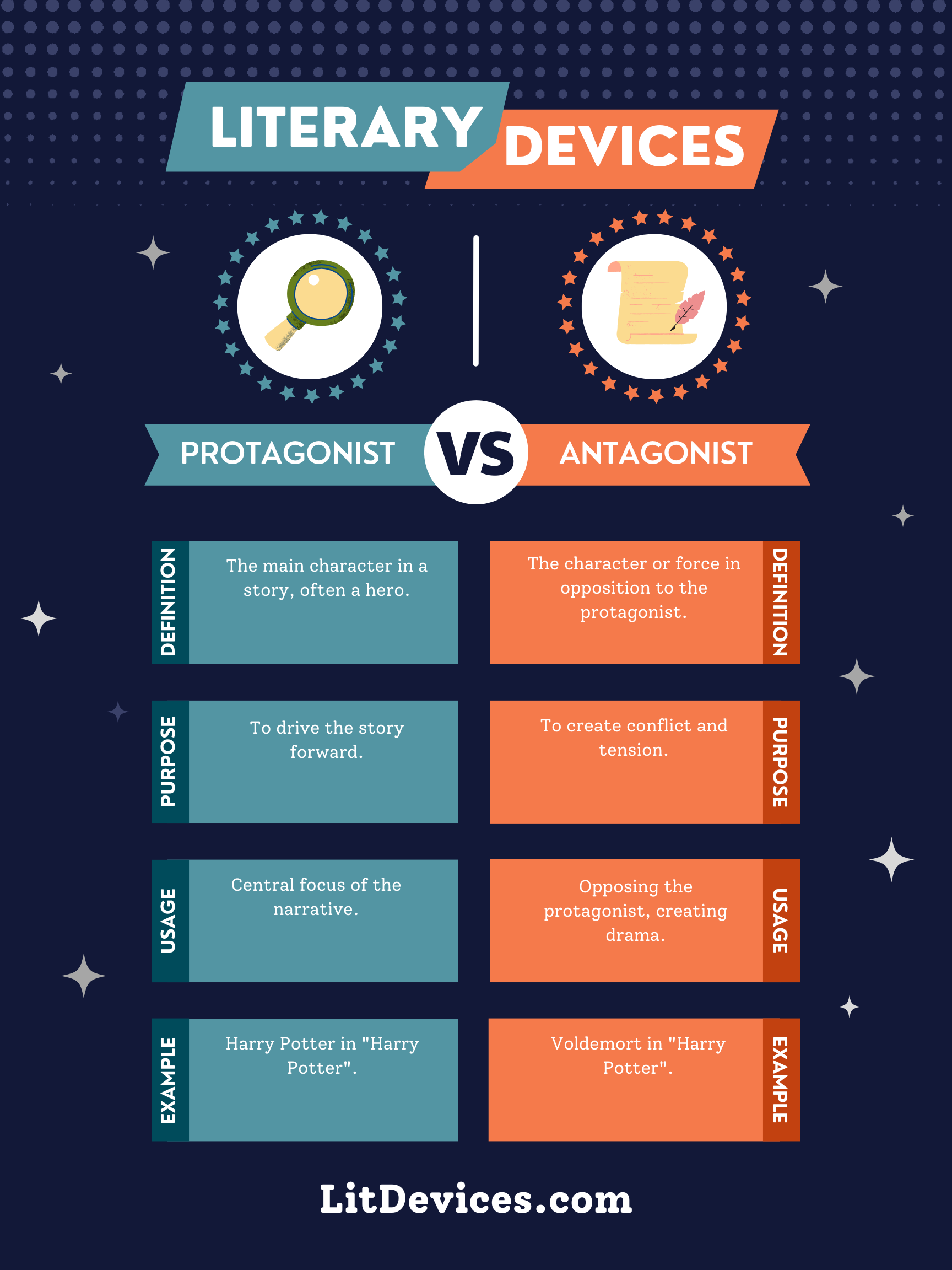The protagonist is the main character, often the hero; The antagonist is the opposing force, often the villain.
In the rich tapestry of storytelling, protagonists and antagonists play pivotal roles that drive narratives forward. These characters are the heart and soul of stories, creating conflicts, evoking emotions, and leading us through unforgettable journeys. Let’s explore these fascinating literary devices in detail, adding a sprinkle of examples to make our exploration as engaging as possible. 📚✨
Protagonist
The protagonist is often the hero of the story, the main character whose journey we follow. This character is usually faced with a conflict that needs resolving, making their story compelling and relatable. Harry Potter, for instance, is a classic example of a protagonist. As a young wizard facing the dark wizard Voldemort, Harry’s journey of growth, discovery, and courage captivates readers worldwide.
Antagonist
Contrastingly, the antagonist is the opposing force that stands in the way of the protagonist’s goals. Often but not always the villain, antagonists are crucial for developing the story’s conflict. They challenge the protagonist, forcing them to evolve. A memorable example is Darth Vader from “Star Wars,” whose formidable presence and complex relationship with the protagonist, Luke Skywalker, add depth to the saga.
Summary
| Literary Device | Definition | Purpose | Usage | Relevant Examples |
|---|---|---|---|---|
| Protagonist | The main character, often portrayed as the hero. | To evoke empathy and drive the story forward. | Central focus, character development, conflict. | Harry Potter, Elizabeth Bennet. |
| Antagonist | The opposing force, often portrayed as the villain. | To create conflict and challenge the hero. | Conflict creation, thematic depth, evolution. | Darth Vader, The White Witch. |
Writing Tips
For writers eager to craft compelling protagonists and antagonists, consider the following tips:
- Understand Their Motivations: Every character should have clear motivations, whether it’s the protagonist’s desire to overcome adversity or the antagonist’s goal to oppose them. Understanding these motivations will add depth to your characters.
- Create Complex Characters: Avoid making your antagonist purely evil or your protagonist entirely virtuous. Complex characters with flaws and virtues are more relatable and interesting.
- Show, Don’t Tell: Use actions and dialogues to reveal your characters’ personalities and motivations rather than explicitly stating them.
- Evolve Your Characters: Allow your characters to grow and change throughout the story. This evolution makes for a more compelling narrative.
Examples: Consider how Elizabeth Bennet’s prejudices and Mr. Darcy’s pride evolve in “Pride and Prejudice,” adding layers to their characters.
FAQs
What makes a protagonist different from an antagonist?
The protagonist is the main character we root for, often facing a conflict that drives the story. The antagonist opposes the protagonist, creating the central conflict.
Can a story have more than one protagonist or antagonist?
Yes, stories can have multiple protagonists or antagonists, adding complexity to the narrative and its conflicts.
How do antagonists contribute to the protagonist’s development?
Antagonists challenge protagonists, forcing them to confront their weaknesses, adapt, and grow. This conflict drives the story and character development.
Exercise
Read the following paragraph and identify the protagonist and antagonist:
“In a quiet village, Ella, an aspiring writer, discovers a mysterious old book that promises great wisdom but is guarded by the enigmatic Mr. Thorn, who warns her of the book’s dangerous powers. Despite the warnings, Ella’s curiosity leads her into a world of adventure and peril.”
Answers: Ella is the protagonist, and Mr. Thorn is the antagonist.
Other Interesting Literary Device Comparisons
- Foreshadowing vs. Flashback: These narrative techniques manipulate time to enhance the story’s depth and suspense.
- First-Person vs. Third-Person Narrative: The choice of narrative perspective can profoundly affect the intimacy and scope of the story.
- Static vs. Dynamic Characters: Examining how characters change (or don’t) throughout the narrative can reveal themes and character motivations.
Exploring these devices further can offer writers and readers alike deeper insights into the art of storytelling. 📘💫

